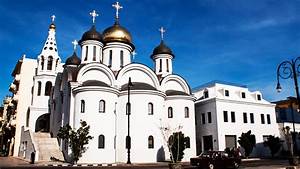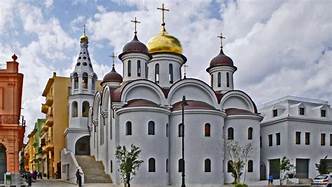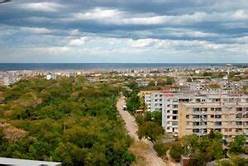LA CATEDRAL ortodoxa Nuestra Señora de Kazán, es un templo ortodoxo ruso situado en la Avenida del Puerto, entre las calles Sol y Santa Clara, próximas a la Alameda de Paula en La Habana Vieja, zona más antigua de la capital de Cuba, declarada por la Unesco como Patrimonio de la humanidad. Fue construida en una parcela de terreno que tenía un edificio en ruinas y se recuperó para la iglesia.
Concebida por el arquitecto ruso Alexey Vorontsov, y su colega cubano Jaime Rodríguez, se trata de una edificación monumental bizantina, finalizada en 2008, que abarca un área de 1200 metros cuadrados. En la planta baja del templo están ubicados las áreas administrativas, las habitaciones del padre, el baño público, la cocina, un salón de reuniones y una sala de computación. En la parte superior está la iglesia, con capacidad para quinientas personas, que pueden acceder mediante dos escaleras de granito.
CONSTRUCCION
La presencia de la Iglesia ortodoxa en Cuba comienza a inicios de los años 1900s cuando en la isla existía una comunidad ortodoxa compuesta por emigrantes de origen griego, ruso y de otros países eslavos.
Para 1964 se reconoce legalmente la Asociación Cristiana Ortodoxa de Cuba. En 1971, el entonces Arzobispo de Jarkov y Exarca de la Iglesia ortodoxa rusa del Patriarcado de Moscú en Centro y Sudamérica, ordenó como Presbítero a un diácono cubano.
En 1978 se autodisuelve la Asociación Cristiana Ortodoxa de Cuba.
En la década de los años 90 los fieles ortodoxos rusos y de otras naciones eslavas, comenzaron a reorganizar la comunidad de creyentes, compuesta fundamentalmente por descendientes de esas nacionalidades, diplomáticos o ciudadanos de esos países que habían creado familias en Cuba, bajo la atención del Patriarcado de Moscú y de Toda Rusia.
Para octubre del 2001 se acordó la construcción de un templo para la Iglesia ortodoxa rusa.
La primera piedra de la catedral fue puesta en su lugar el 14 de febrero de 2006. Fue finalizada 32 meses después, el 19 de octubre de 2008, consagrada por Kiril hoy Patriarca de Moscú y de toda Rusia entonces Metropolita Smolensk y Kaliningrado y Presidente del Departamento de Relaciones Eclesiásticas Exteriores del Patriarcado de Moscú, presidió la ceremonia de colocación de la primera piedra de su nuevo templo ortodoxo ruso en La Habana, en la actualidad Patriarca de Moscú. Posteriormente fue visitada por el entonces presidente ruso Dmitri Medvédev.
Fue ejecutada por especialistas de la Oficina del Historiador y especialistas de Rusia. Abarca un área de 1200 metros cuadrados.
El Ingeniero Pedro Rodríguez, fue el proyectista estructural, tanto el como Jaime Rodriguez viajaron a Rusia para familiarizarse con este tipo de construcciones.
Solo dos días bastaron para completar el montaje de las seis cúpulas (cinco en la iglesia y una en el campanario) e igual cantidad de cruces, que hoy coronan la Sacra Catedral Ortodoxa Rusa Nuestra Señora de Kazán. Después de trasladar sus piezas, procedentes de Rusia hasta la capital cubana, los especialistas de ese país se instalaron en unos de los espigones situados en la Alameda de Paula, área cercana al templo, y allí armaron las cubiertas en forma de cebolla, forraron con cobre y laminaron en oro, y así hicieron con las cruces.
La iglesia de estilo bizantino tiene seis vistosas cúpulas, dos laminadas en oro (la mayor y la menor) y cuatro en bronce, las cuales están coronadas por cuatro cruces de oro sólido. La escalera de acceso fue construida con granito de la provincia de Sancti Spíritus y se dice que es la segunda más grande entre las construidas fuera de Rusia, solo antecedida por una en Israel.
El sistema constructivo utilizó el abovedado y prescindió de cabillas, cemento, ni madera para encofrarlo.Está dividida en 11 áreas fundamentales: la morada del Arcipreste; el salón de reuniones; la Pila Bautismal, un área técnica; la Basílica; la Diócesis con un bloque habitacional; el mirador, la cocina, biblioteca, baños públicos y una tienda de utensilios religiosos.
El iconostasio o altar interior de oro fue construido en el monasterio de la Trinidad y San Sergio en Rusia por maestros pintores y escultores. Las paredes poco a poco se adornaron con murales, como indica la tradición bizantina.
Llama la atención su escalera de entrada, construida en granito de Sancti Spíritus, y es considerada la segunda escalera más grande de todas fuera de Rusia.
Del interior destaca su altar de oro, construido en Trinidad y el Monasterio de San Sergio, Rusia; y los murales que adornan sus paredes.
El edificio tiene 1.200 metros cuadrados y consta de tres elementos principales: la iglesia, la diócesis y el campanario. El exotismo misterioso que posee contrasta con la imagen tradicional de pueblo cubano.
La entrada principal es por la calle San Pedro. La parte posterior del templo, el fondo del altar, da al puerto. El patriarca hace la liturgia dentro del altar, de frente al este en el iconostasio, donde se encuentran los santos a los que se consagra esta iglesia, dedicada a la virgen de Kazán de Rusia.
OUR LADY DE KASAN ORTHODOX CATEDRAL, LA HABANA, CUBA. UNESCO WORLD HERITAGE SITE. PHOTOS.
THE OUR LADY of Kazan Orthodox Cathedral is a Russian Orthodox temple located on Avenida del Puerto, between Sol and Santa Clara streets, close to Alameda de Paula in Old Havana, the oldest area of the capital of Cuba, declared by UNESCO as a World Heritage Site. It was built on a plot of land that had a dilapidated building and was reclaimed for the church.
Conceived by the Russian architect Alexey Vorontsov, and his Cuban colleague Jaime Rodríguez, it is a monumental Byzantine building, completed in 2008, which covers an area of 1,200 square meters. On the ground floor of the temple are located the administrative areas, the father’s rooms, the public bathroom, the kitchen, a meeting room, and a computer room. At the top is the church, with a capacity of five hundred people, which can be accessed by two granite stairs.
CONSTRUCTION
The presence of the Orthodox Church in Cuba began in the early 1900s when there was an Orthodox community on the island made up of immigrants of Greek, Russian, and other Slavic origins.
By 1964 the Orthodox Christian Association of Cuba was legally recognized. In 1971, the then Archbishop of Kharkov and Exarch of the Russian Orthodox Church of the Moscow Patriarchate in Central and South America ordained a Cuban deacon as Priest.
In 1978 the Orthodox Christian Association of Cuba dissolved itself.
In the 1990s, the Russian Orthodox faithful and those of other Slavic nations began to reorganize the community of believers, made up mainly of descendants of those nationalities, diplomats, or citizens of those countries who had created families in Cuba, under the care of the Patriarchate of Moscow and All Russia.
By October 2001, the construction of a temple for the Russian Orthodox Church was agreed upon.
The first stone of the cathedral was laid in its place on February 14, 2006. It was completed 32 months later, on October 19, 2008, consecrated by Kiril, today Patriarch of Moscow and All Russia, then Metropolitan Smolensk and Kaliningrad and President of the Department of Foreign Ecclesiastical Relations of the Moscow Patriarchate, presided over the laying ceremony of the first stone of his new Russian Orthodox temple in Havana, currently Patriarch of Moscow. Later it was visited by then Russian President Dmitri Medvedev.
It was executed by specialists from the Office of the Historian and specialists from Russia. It covers an area of 1200 square meters.
Engineer Pedro Rodríguez was the structural designer, both he and Jaime Rodríguez traveled to Russia to become familiar with this type of construction.
Only two days were enough to complete the assembly of the six domes (five in the church and one in the bell tower) and the same number of crosses, which today crown the Holy Russian Orthodox Cathedral of Our Lady of Kazan. After moving their pieces, coming from Russia to the Cuban capital, the specialists from that country settled in one of the breakwaters located in the Alameda de Paula, an area near the temple, and there they assembled the onion-shaped covers, lined with copper and laminated in gold, and so they did with the crosses.
The Byzantine-style church has six colorful domes, two laminated in gold (the largest and the smallest) and four in bronze, which are crowned by four solid gold crosses. The access staircase was built with granite from the province of Sancti Spíritus and is said to be the second-largest among those built outside of Russia, only preceded by one in Israel.
The construction system used vaulting and dispensed with rebar, cement, or wood to form it. It is divided into 11 fundamental areas: the Archpriest’s dwelling; the meeting room; the Baptismal Font, a technical area; the Basilica; the Diocese with a housing block; the lookout, the kitchen, library, public baths, and a store of religious utensils.
The golden iconostasis or inner altar was built in the Trinity and St. Sergius monastery in Russia by master painters and sculptors. The walls were gradually adorned with murals, as indicated by the Byzantine tradition.
Its entrance staircase, built-in granite from Sancti Spíritus, is striking and is considered the second-largest staircase outside of Russia.
From the interior, its golden altar stands out, built-in Trinidad and the Monastery of San Sergio, Russia; and the murals that adorn its walls.
The building is 1,200 square meters and consists of three main elements: the church, the diocese, and the bell tower. The mysterious exoticism that it possesses contrasts with the traditional image of the Cuban people.
The main entrance is on Calle San Pedro. The back of the temple, the bottom of the altar, faces the port. The patriarch does the liturgy inside the altar, facing east on the iconostasis, where the saints to whom this church is consecrated, dedicated to the Virgin of Kazan of Russia, are found.
Agencies . Wiki . Ecured . Extractos . Excerpts . Internet Photos . Arnoldo Varona . www.TheCubanHistory.com
THE CUBAN HISTORY, HOLLYWOOD.



 CATEDRAL Ortodoxa Nuestra Señora de Kasán, La Habana, Cuba. UNESCO Patrimonio de la Humanidad. * OUR LADY de Kasan Orthodox Catedral, La Havana, Cuba. UNESCO World Heritage Site. PHOTOS.
CATEDRAL Ortodoxa Nuestra Señora de Kasán, La Habana, Cuba. UNESCO Patrimonio de la Humanidad. * OUR LADY de Kasan Orthodox Catedral, La Havana, Cuba. UNESCO World Heritage Site. PHOTOS.







